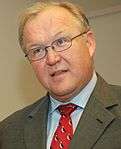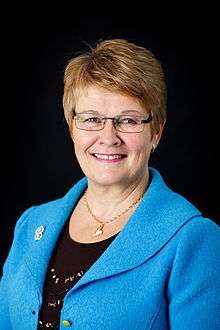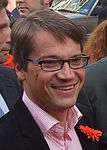Swedish general election, 2006
| | |||||||||||||||||||||||||||||||||||||||||||||||||||||||||||||||||||||||||||||||||||||||||||||||||||||||||||||||||||||||||||||||||
| |||||||||||||||||||||||||||||||||||||||||||||||||||||||||||||||||||||||||||||||||||||||||||||||||||||||||||||||||||||||||||||||||
| |||||||||||||||||||||||||||||||||||||||||||||||||||||||||||||||||||||||||||||||||||||||||||||||||||||||||||||||||||||||||||||||||
| |||||||||||||||||||||||||||||||||||||||||||||||||||||||||||||||||||||||||||||||||||||||||||||||||||||||||||||||||||||||||||||||||
A general election was held in Sweden on 17 September 2006, to elect members to the Riksdag, the Swedish national legislature. All 349 seats were up for election: 310 fixed seats in 29 constituencies and 39 adjustment seats, used to ensure that parties have representation in the Riksdag proportional to their share of the national vote. The electoral system used was semi-open list proportional representation using the Sainte-Laguë method of allocating seats. Elections for County and Municipal councils were also held on the same day.
Fredrik Reinfeldt from the Moderate Party was able to form a majority government together with the Centre Party, Liberal People's Party and the Christian Democrats following the election. The Social Democrats were ousted after twelve years in power. It was the country's first majority government since the Social Democrats alone held a majority between 1968 and 1970.
The contenders for government
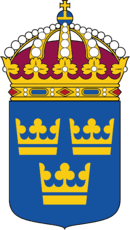 |
| This article is part of a series on the politics and government of Sweden |
|
| Foreign relations |
|
Related topics |
The minority government of Göran Persson's Social Democratic Party attempted, and failed, to gain enough seats to form a majority government, to continue as a minority or to govern in a red-green coalition government. His party had been in power since the 1994 election, and Persson had been Prime Minister since 1996. The Social Democrats before the election had an agreement with the Left Party and the Green Party that gave them an influence on government policy in exchange for their support. However, both the Left Party and the Green Party insisted that any red-green government formed after the election would need to include them in a coalition.[1]
The four centre-right parties – The Moderate Party (m), The Liberal People's Party (fp), The Christian Democrats (kd), and The Centre Party (c) – united in Alliance for Sweden succeeded in gaining enough seats to form a coalition government. The four parties (formerly in opposition) had presented a joint election manifesto (although c, fp, and kd still had individual manifestos). Their candidate for Prime Minister was the Moderate Party leader, Fredrik Reinfeldt.
The election campaign
The campaigning for the 2006 election began early, as the opposition decided to present itself as a viable alternative government by forming an alliance: Alliance for Sweden. This alliance was negotiated at a meeting held in the village of Högfors, home to the chairman of the Centre Party, Maud Olofsson. The meeting ended on 31 August 2004 with the presentation of a joint declaration outlining the principles under which the four parties intended to run in the election.[2] One year later a similar meeting was held at Bankeryd, home of Göran Hägglund, leader of the Christian Democrats.[3] See Alliance for Sweden for further information.
The Alliance enjoyed a leading position for over a year over the red-green parties, according to most polls. However the gap between the two blocs (s, v, and mp are assumed to work together) began to close rapidly in January 2006, and the red-green parties took the lead in May 2006; indeed they were ahead of the Alliance in every poll conducted in May and June. However, there was a late shift in opinion back to the Alliance during the summer: in mid-August all polls showed the Alliance leading the red-green parties comfortably.
Unemployment
The Social Democrat government's perceived failure to reduce unemployment was a major issue in the campaign, especially considering the good performance of the Swedish economy (when compared with that of the rest of Europe). The opposition also argued that "real" unemployment was much higher than the official figure of 4.8% (as of May 2006[4]). They quoted a figure of 1,037,000 (or 17.9% of the labour force in January 2006) for those who are "outside the labour market because they do not have a job or are studying".[5] If those who are "wholly or partially outside the labour market" are included then the figure rises to 1,700,000.[6] This gloomy view of the unemployment situation was raised by Jan Edling, a former economist for the Swedish Trade Union Confederation (LO). However, compared with other OECD countries Sweden has a low "broad unemployment", as was pointed out by the Green Party's Peter Eriksson in the debate.[7]
Alliance for Sweden proposed to address the problem by cutting income tax for the lowest paid (by increasing the tax-free allowance), cutting the payroll tax (and abolishing it for parts of the service sector), and making wages paid for household work tax-deductible.[8] Critics of the proposed tax cuts said that, because they are funded by reducing unemployment benefit and sick pay, they would attack the most needy in society rather than helping them as Alliance for Sweden claimed.
In addition the Centre Party proposed a special youth contract of employment for those aged under 26, allowing their term of employment to be ended by their employer up to two years after they begin work.[9] This controversial proposal (not adopted by the Alliance as a whole) was intended to increase youth employment by making taking on new employees less risky for the employer, but it was criticised by the red-green parties as reducing job security for the young. A similar contract introduced by the French government (the Contrat première embauche) caused angry demonstrations and riots in France.[10][11] In a debate article in Göteborgs-Posten on 21 March 2006 Wanja Lundby-Wedin, Chairperson of LO, wrote:
"[Maud Olofsson's] new proposal to abolish job security for the young will not result in more jobs. It will only lead to increased insecurity and an even larger exclusion... More than half of youths under 25 who work already have an insecure job; a time-limited job of some sort. This is most usual among our young female members. The most insecure jobs, 'need-employment' or the so-called 'phone and run locum' is entirely on the employer's terms. Every morning many people sit and wait for their employer to ring. Am I needed today or not?".[12]
Olofsson replied two days later in the same newspaper:
"What LO's Chairperson has not understood is that those youths who already have a job are not covered by our proposal. It does however give a new opportunity for the 146,000 youths who are wholly or partially living in the exclusion the Social Democrats have created... One of the main reasons why companies don't take on new staff is that the risk is too large. If the gamble doesn't pay off then the costs are too great. By lowering the threshold for job creation we are convinced that many youths will be able to take their first steps onto a labour market that they today have never been able to set foot on. We are equally convinced that the great majority of these youths will show their employers that they were right to dare to employ them".[13]
A survey carried out by the Confederation of Swedish Enterprise (Svenskt Näringsliv) indicates that 41% of Swedish companies believe that such a contract would increase their willingness to hire young people "to a great extent" and that 51% believe that it would increase it "to a certain extent". 7% of those surveyed said that they did not think that they would be more willing to hire.[14][15]
Computer break-in by Liberal People's Party members
On 4 September 2006, only two weeks before the general election, the Social Democratic Party reported to the police a computer break-in into its internal network. It has been reported that members of the Liberal People's Party copied secret information, not yet officially released, on at least two occasions for the purpose of counter-attacking Social Democratic political propositions. On 5 September the Liberal Party Secretary Johan Jakobsson voluntarily resigned. Leading members of the party and its youth organization are under police investigation suspected for criminal activity.
Pre-election opinion polls
The charts below show the results of pre-election polls conducted by the five major polling institutes in Sweden.
TEMO has a summary of all polls conducted since the election in 2002, and is therefore cited as the reference for each poll.
Temo
| Party | August 2006 | July 2006 | June 2006 | May 2006 | April 2006 | March 2006 | February 2006 | January 2006 | December 2005 | November 2005 | October 2005 | September 2005 | Last election | |
|---|---|---|---|---|---|---|---|---|---|---|---|---|---|---|
| Social Democrats (s) | 37.7% | 34.8% | 36.8% | 38.3% | 36.5% | 34.9% | 36.3% | 34.3% | 34.5% | 35.7% | 32.1% | 35.5% | 39.9% | |
| Moderate Party (m) | 28.0% | 28.6% | 26.3% | 26.9% | 27.9% | 29.2% | 28.4% | 30.9% | 30.3% | 27.6% | 31.6% | 31.4% | 15.3% | |
| Liberal People's Party (fp) | 9.8% | 10.2% | 9.9% | 8.7% | 9.9% | 9.7% | 10.5% | 10.0% | 10.4% | 9.4% | 9.4% | 8.7% | 13.4% | |
| Christian Democrats (kd) | 5.4% | 5.6% | 5.6% | 5.9% | 6.3% | 6.4% | 5.1% | 4.4% | 4.9% | 4.0% | 4.3% | 3.7% | 9.1% | |
| Left Party (v) | 3.6% | 4.7% | 5.9% | 5.4% | 5.1% | 6.2% | 6.0% | 6.2% | 5.2% | 6.1% | 5.9% | 5.7% | 8.4% | |
| Centre Party (c) | 6.1% | 5.7% | 5.8% | 6.3% | 6.0% | 5.3% | 6.2% | 5.6% | 6.2% | 6.5% | 5.6% | 6.8% | 6.2% | |
| Green Party (mp) | 5.3% | 5.8% | 4.5% | 4.9% | 5.3% | 5.1% | 4.6% | 4.8% | 5.2% | 4.8% | 4.6% | 4.7% | 4.6% | |
| June List (jl) | - | - | - | - | - | - | 1.2% | 1.0% | 3.2% | 4.5% | - | - | NA | |
| Alliance for Sweden (m, c, fp, kd) | 49.3% | 50.1% | 47.6% | 47.8% | 50.1% | 50.6% | 50.2% | 50.9% | 51.8% | 47.5% | 50.9% | 50.6% | 44.0% | |
| Red-Green bloc (s, v, mp) | 46.5% | 45.2% | 47.2% | 48.6% | 46.8% | 46.2% | 46.9% | 45.3% | 44.9% | 46.6% | 42.6% | 45.9% | 52.9% | |
| Undecided (?) | 22.6% | 22.8% | 18.6% | 19.6% | 20.3% | 21.2% | NA% | NA% | NA% | NA% | NA% | NA% | NA | |
Sifo
| Party | 7 September 2006 | August 2006 | August 2006 | August 2006 | June 2006 | May 2006 | April 2006 | March 2006 | February 2006 | January 2006 | December 2005 | Last election | |
|---|---|---|---|---|---|---|---|---|---|---|---|---|---|
| Social Democrats (s) | 35.7% | 35.8% | 34.1% | 34.6% | 37.6% | 36.6% | 36.2% | 36.2% | 34.9% | 35.3% | 33.2% | 39.9% | |
| Moderate Party (m) | 26.0% | 24.3% | 28.6% | 26.7% | 26.9% | 25.2% | 26.2% | 28.2% | 28.1% | 30.9% | 29.7% | 15.3% | |
| Liberal People's Party (fp) | 7.6% | 10.2% | 11.1% | 10.3% | 9.2% | 11.7% | 11.5% | 10.2% | 10.7% | 9.3% | 10.6% | 13.4% | |
| Christian Democrats (kd) | 7.5% | 6.5% | 7.0% | 6.9% | 5.0% | 5.2% | 5.4% | 5.9% | 6.0% | 4.8% | 4.6% | 9.1% | |
| Left Party (v) | 7.1% | 5.6% | 5.9% | 5.6% | 6.1% | 6.8% | 6.4% | 5.6% | 6.0% | 6.7% | 6% | 8.4% | |
| Centre Party (c) | 6.2% | 6.7% | 4.9% | 6.6% | 6.2% | 5.8% | 5.3% | 6.7% | 5.8% | 6.9% | 6.7% | 6.2% | |
| Green Party (mp) | 5.7% | 6.0% | 4.5% | 5.9% | 5.2% | 5.5% | 5.2% | 4.4% | 4.9% | 4.1% | 4.5% | 4.6% | |
| June List (jl) | - | - | - | - | - | - | - | 2.2% | - | - | - | NA | |
| Alliance for Sweden (m, c, fp, kd) | 47.3% | 47.7% | 51.5% | 50.5% | 47.3% | 47.9% | 48.4% | 51.0% | 50.6% | 51.9% | 51.6% | 44.0% | |
| Red-Green bloc (s, v, mp) | 48.2% | 47.3% | 44.9% | 46.1% | 48.9% | 48.9% | 47.8% | 46.2% | 45.8% | 46.1% | 43.7% | 52.9% | |
| Undecided (?) | - | 15.1% | 20.0% | 19.2% | 17.6% | 17.4% | 18.9% | 16.2% | 17.8% | 17.9% | 20.5% | NA | |
Demoskop
| Party | August 2006 | July 2006 | June 2006 | May 2006 | April 2006 | March 2006 | February 2006 | January 2006 | December 2005 | November 2005 | October 2005 | September 2005 | August 2005 | July 2005 | Last election | |
|---|---|---|---|---|---|---|---|---|---|---|---|---|---|---|---|---|
| Social Democrats (s) | 33.7% | 35.7% | 37.4% | 36.2% | 37.8% | 36.4% | 36.3% | 37.9% | 31.9% | 33.1% | 35.3% | 35.8% | 31.7% | 29.3% | 39.9% | |
| Moderate Party (m) | 30.4% | 30.9% | 27.4% | 30.3% | 30.0% | 31.0% | 31.6% | 30.8% | 30.5% | 31.3% | 30.8% | 30.6% | 31.6% | 35.8% | 15.3% | |
| Liberal People's Party (fp) | 9.9% | 8.0% | 8.8% | 10.0% | 8.8% | 9.3% | 9.1% | 10.1% | 9.7% | 9.3% | 11% | 8.7% | 10.8% | 9.7% | 13.4% | |
| Christian Democrats (kd) | 5.5% | 5.3% | 5.7% | 4.0% | 4.9% | 3.6% | 4.0% | 3.6% | 4.5% | 3.1% | 3.3% | 4.0% | 4.8% | 4.3% | 9.1% | |
| Left Party (v) | 6.9% | 4.4% | 6.9% | 7.1% | 5.2% | 4.5% | 7.2% | 5.6% | 6.7% | 7.3% | 5.9% | 8.1% | 5.2% | 6.2% | 8.4% | |
| Centre Party (c) | 4.6% | 7.3% | 5.4% | 3.6% | 4.8% | 5.9% | 4.7% | 4.2% | 6.3% | 6.7% | 4.7% | 5.8% | 7.8% | 6.5% | 6.2% | |
| Green Party (mp) | 5.2% | 4.2% | 6.2% | 5.5% | 4.9% | 5.1% | 5.5% | 6.2% | 6.2% | 4.2% | 4.2% | 4.4% | 6.2% | 4.7% | 4.6% | |
| Alliance for Sweden (m, c, fp, kd) | 50.5% | 51.5% | 47.3% | 47.9% | 48.5% | 49.8% | 49.4% | 48.7% | 51.0% | 50.4% | 49.8% | 49.1% | 55.0% | 56.3% | 44.0% | |
| Red-Green bloc (s, v, mp) | 45.8% | 44.3% | 50.5% | 48.8% | 47.9% | 46.0% | 49.0% | 49.7% | 44.8% | 44.6% | 45.4% | 48.3% | 43.1% | 40.2% | 52.9% | |
Skop
| Party | August 2006 | July 2006 | June 2006 | May 2006 | April 2006 | March 2006 | February 2006 | January 2006 | December 2005 | Last election | |
|---|---|---|---|---|---|---|---|---|---|---|---|
| Social Democrats (s) | 35.5% | 34.5% | 36.2% | 37.8% | 34.7% | 39.0% | 36.3% | 35.9% | 36.9% | 39.9% | |
| Moderate Party (m) | 26.9% | 24.2% | 25.3% | 24.8% | 21.9% | 23.5% | 26.7% | 23.9% | 24.2% | 15.3% | |
| Liberal People's Party (fp) | 10.1% | 10.9% | 12.0% | 10.2% | 12.7% | 9.6% | 11.0% | 11.8% | 10.7% | 13.4% | |
| Christian Democrats (kd) | 7.2% | 6.8% | 6.2% | 6.4% | 6.9% | 6.4% | 6.0% | 6.6% | 4.6% | 9.1% | |
| Left Party (v) | 4.4% | 5.9% | 5.9% | 6.5% | 7.6% | 5.7% | 5.4% | 6.9% | 6.3% | 8.4% | |
| Centre Party (c) | 6.1% | 7.2% | 5.9% | 6.2% | 7.4% | 6.9% | 6.4% | 6.6% | 6.9% | 6.2% | |
| Green Party (mp) | 5.1% | 6.6% | 4.8% | 4.8% | 5.3% | 5.7% | 5.0% | 4.6% | 6.9% | 4.6% | |
| June List (jl) | 2.0% | 1.2% | - | 1.4% | - | 1.0% | 1.0% | 1.6% | 1.6% | NA | |
| Alliance for Sweden (m, c, fp, kd) | 50.3% | 49.1% | 49.4% | 47.6% | 48.9% | 46.4% | 50.1% | 48.9% | 46.4% | 44.0% | |
| Red-Green bloc (s, v, mp) | 45.3% | 47.3% | 46.9% | 49.1% | 47.2% | 50.4% | 46.7% | 47.4% | 50.1% | 52.9% | |
Ruab
| Party | August 2006 | June 2006 | May 2006 | April 2006 | March 2006 | February 2006 | January 2006 | December 2005 | Last election | |
|---|---|---|---|---|---|---|---|---|---|---|
| Social Democrats (s) | 40.4% | 37.2% | 36.8% | 35.2% | 37.1% | 35.4% | 36.4% | 38.0% | 39.9% | |
| Moderate Party (m) | 29.1% | 30.4% | 29.9% | 32.9% | 30.2% | 32.0% | 31.3% | 29.0% | 15.3% | |
| Liberal People's Party (fp) | 8.7% | 8.4% | 8.8% | 8.9% | 11.0% | 9.7% | 8.7% | 9.3% | 13.4% | |
| Christian Democrats (kd) | 5.0% | 4.7% | 4.7% | 5.2% | 2.8% | 3.7% | 4.0% | 4.2% | 9.1% | |
| Left Party (v) | 4.6% | 5.5% | 7.1% | 5.6% | 5.3% | 4.9% | 5.0% | 4.2% | 8.4% | |
| Centre Party (c) | 5.1% | 5.0% | 4.6% | 4.5% | 5.8% | 4.7% | 6.8% | 6.7% | 6.2% | |
| Green Party (mp) | 4.6% | 6.3% | 5.1% | 5.2% | 4.6% | 6.6% | 5.6% | 4.7% | 4.6% | |
| June List (jl) | - | - | - | - | - | - | 1.1% | 1.5% | NA | |
| Alliance for Sweden (m, c, fp, kd) | 47.9% | 48.5% | 48.0% | 51.5% | 49.8% | 50.1% | 50.8% | 49.2% | 44.0% | |
| Red-Green bloc (s, v, mp) | 49.6% | 49.0% | 49.0% | 46.0% | 47.0% | 46.9% | 47.0% | 46.9% | 52.9% | |
Results
The final results were published on 21 September 2006 by the Swedish Election Authority (Valmyndigheten).[21] Apart from separating the minor parties, there were no big changes to the preliminary count from the election night. 6,892,009 people were eligible to vote in the election. The results are here compared with the 2002 election.
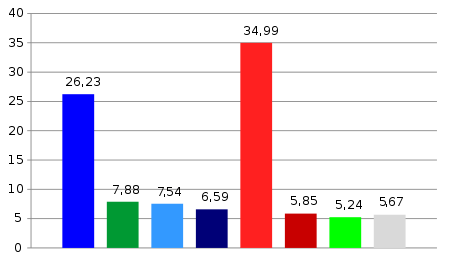
- Moderate
- Centre
- Liberal People's
- Christian Democrats
- Social Democratic
- Left
- Green
- Other parties
| Parties and coalitions | Votes | Permanent seats | Adjustment seats | Total seats | seats %/votes % | |||||||
|---|---|---|---|---|---|---|---|---|---|---|---|---|
| # | % & ±% | # | ± | # | ± | seats & swing | ||||||
| Swedish Social Democratic Party Socialdemokraterna |
1,942,625 | 34.99 |
129 | 1 | 130 |
1,06 | ||||||
| Moderate Party Moderaterna |
1,456,014 | 26.23 |
93 | 4 | 97 |
1,06 | ||||||
| Centre Party Centerpartiet |
437,389 | 7.88 |
27 | 2 | 29 |
1,05 | ||||||
| Liberal People's Party Folkpartiet liberalerna |
418,395 | 7.54 |
22 | 6 | 28 |
1,06 | ||||||
| Christian Democrats Kristdemokraterna |
365,998 | 6.59 |
17 | 7 | 24 |
1,04 | ||||||
| Left Party Vänsterpartiet |
324,722 | 5.85 |
13 | 9 | 22 |
1,08 | ||||||
| Green Party Miljöpartiet de Gröna |
291,121 | 5.24 |
9 | 10 | 19 |
1,04 | ||||||
| Sweden Democrats Sverigedemokraterna |
162,463 | 2.93 |
0 | 0 | 0 | |||||||
| Feminist Initiative Feministiskt initiativ |
37,954 | 0.68 | 0 | 0 | 0 | |||||||
| Pirate Party Piratpartiet |
34,918 | 0.63 | 0 | 0 | 0 | |||||||
| Swedish Senior Citizen Interest Party Sveriges pensionärers intresseparti |
28,806 | 0.52 |
0 | 0 | 0 | |||||||
| June List Junilistan |
26,072 | 0.47 | 0 | 0 | 0 | |||||||
| Health Care Party Sjukvårdspartiet |
11,519 | 0.21 | 0 | 0 | 0 | |||||||
| National Democrats Nationaldemokraterna |
3,064 | 0.06 |
0 | 0 | 0 | |||||||
| Unity Enhet |
2,648 | 0.05 |
0 | 0 | 0 | |||||||
| National Socialist Front Nationalsocialistisk Front |
1,417 | 0.03 | 0 | 0 | 0 | |||||||
| New Future Ny Framtid |
1,171 | 0.02 |
0 | 0 | 0 | |||||||
| Socialist Justice Party Rättvisepartiet Socialisterna |
1,097 | 0.02 |
0 | 0 | 0 | |||||||
| People's Will Folkets vilja |
881 | 0.02 | 0 | 0 | 0 | |||||||
| Parties with less than 500 votes | 4,766 | 0.08 | – | – | – | – | ||||||
| Alliance for Sweden (Moderate Party, Centre Party, Liberal People's Party, Christian Democrats) |
2,677,796 | 48.24 |
178 | |||||||||
| Red–green bloc (Social Democrats, Left Party, Green Party) |
2,558,468 | 46.08 |
171 | |||||||||
| Blank votes | 96,922 | 1.72 | ||||||||||
| Other invalid votes | 2216 | 0.04 | ||||||||||
| Turnout | 5,650,416 | 81.99 |
||||||||||
Three hours after the polls closed, the result was clear enough for Moderate Party leader Fredrik Reinfeldt to declare himself the victor and for Göran Persson to announce his resignation as Prime Minister and as leader of the Social Democratic Party. The four centre-right parties of Alliance for Sweden formed, as expected, a government with Fredrik Reinfeldt as Prime Minister. The Speaker had asked Reinfeldt to begin this formation on 19 September but, as is usual, requested the Cabinet of Göran Persson to stay on as a caretaker government until the Riksdag formally elected a new prime minister. The newly elected Riksdag convened on 2 October and the government was presented on 6 October.[22]
The election result is historic in being the worst result for the Social Democrats ever in a general election with universal suffrage (introduced in 1921) and the best result for the Moderates since 1928.[23]
Minor parties, that are not represented in the Riksdag, got a total of 5.7% of the votes, which was an increase of 2.6 percentage points, compared to the 2002 election. Behind this increase lay a great success for the Sweden Democrats, gaining 2.9% (+1.5 percentage points) and thus surpassing the limit (2.5%) for gaining governmental financial support for the next four years. Two new parties, Feminist Initiative (0.7%) and the Pirate Party (0.6%), also contributed to the increase.[24]
Of the 349 elected Riksdag members, 164 (or 47%) are women.[25]
Interpretive maps
 Votes by municipality. The municipalities are the color of the party that got the most votes within the coalition that won relative majority.
Votes by municipality. The municipalities are the color of the party that got the most votes within the coalition that won relative majority. Votes by municipality as a scale from red/Red-green bloc to blue/Alliance for Sweden.
Votes by municipality as a scale from red/Red-green bloc to blue/Alliance for Sweden. Cartogram of the vote with each municipality rescaled in proportion to the number of valid votes. Deeper blue represents a relative majority for Alliance for Sweden, brighter red represents a relative majority for the Red-Green bloc.
Cartogram of the vote with each municipality rescaled in proportion to the number of valid votes. Deeper blue represents a relative majority for Alliance for Sweden, brighter red represents a relative majority for the Red-Green bloc. Map showing the voting shifts from the 2002 to the 2006 election. Darker blue indicates a municipality voted more towards the parties that form Alliance for Sweden. Darker red indicates a municipality voted more towards the parties that form the red-green bloc.
Map showing the voting shifts from the 2002 to the 2006 election. Darker blue indicates a municipality voted more towards the parties that form Alliance for Sweden. Darker red indicates a municipality voted more towards the parties that form the red-green bloc.
See also
Further reading
- Aylott, Nicholas; Niklas Bolin (May 2007). "Towards a two-party system? The Swedish parliamentary election of September 2006". West European Politics. 30 (3): 621–633. doi:10.1080/01402380701276477.
References
- ↑ There will be Green ministers, The Local, May 22, 2006
- ↑ http://www.maktskifte06.se/fileadmin/Upload/pdf/borgerligtmanifest.pdf
- ↑ http://www.maktskifte06.se/fileadmin/Upload/pdf/Bankeryd050831.pdf
- ↑ Startsida – www.scb.se
- ↑ http://www.moderat.se/artikel.asp?flikid=1&menyid=1&webbid=1&artikelid=14725
- ↑ Archived June 15, 2006, at the Wayback Machine.
- ↑ Moderaternas fejkade arbetslöshetssiffror, Peter Eriksson, September 16, 2006
- ↑ http://www.maktskifte06.se/fileadmin/Upload/pdf/allians_33.pdf
- ↑ Centerns ungdomsavtal får inte politiskt stöd (Swedish), Sydsvenskan, 2 April 2006.
- ↑ Chirac calls for urgent talks after Paris violence, The Guardian, March 18, 2006
- ↑ Police fire rubber bullets at crowds as Paris labour law protest turns into riot, The Guardian, March 17, 2006
- ↑ LO: Maud Olofsson bör lära sig av protesterna i Paris, Göteborgs-Posten, March 21, 2006
- ↑ Vi vill hjälpa ungdomar som LO inte vill se, Göteborgs-Posten, March 23, 2006
- ↑ Företagen tror på ungdomsavtal, Svenskt Näringsliv, March 21, 2006
- ↑ Svenskt Näringsliv
- ↑ http://www.temo.se/upload/326/valjbsamtliga.htm (Swedish)
- ↑ http://www.temo.se/upload/326/valjbsamtliga.htm (Swedish) (latest sample size 1248)
- ↑ http://www.temo.se/upload/326/valjbsamtliga.htm (Swedish) (latest sample size 1002)
- ↑ http://www.temo.se/upload/326/valjbsamtliga.htm (Swedish) (latest sample size 1000)
- ↑ http://www.temo.se/upload/326/valjbsamtliga.htm (Swedish)
- ↑ Allmänna val 17 september 2006
- ↑ Nu ska den nya regeringen bildas, Göteborgs-Posten, September 18, 2006
- ↑ Historisk statistik över valåren 1910 – 2002, Statistics Sweden,
- ↑ Allmänna val 17 september 2006 - Övriga
- ↑ Mest jämställda någonsin, Svenska dagbladet, September 21, 2006
External links
| Wikimedia Commons has media related to Swedish general election, 2006. |
| Wikinews has related news: Opposition alliance wins power in Swedish elections |
- Guide to the Swedish Election 2006 – The Local
- Briefingroom: The insider's guide to... Swedish politics – CNN
- NSD: European Election Database – Sweden publishes regional level election data; allows for comparisons of election results, 1991–2006
